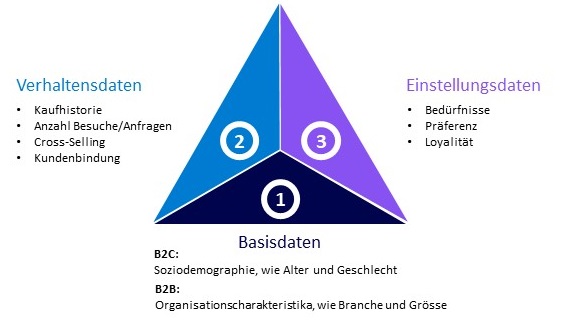How often have we heard from those responsible in companies “we have so much data, we just need to evaluate it properly”? Improving customer centricity starts with a company’s customer data. In this context, the creation of a powerful customer value model is an important element. But beyond that, it’s also a matter of developing segmentations, understanding the customer purchase process, and enabling cross-selling via CRM. So if you want to follow what numerous managers are saying, this blog post is all about evaluating. NO! This paper relates to the 3 data levels of customer centricity and numerous misconceptions in practice on this important topic.
Basics of the 3 data levels of customer centricity:
The 3 levels of customer centricity data include baseline data, behavioral data, and attitudinal data. In B2C sectors, the basic data relates to the socio-demographics of customers: Age, gender, education, income, etc. In B2B sectors, the basic data relates to the company characteristics: Industry, number of employees, region, etc. Behavioral data includes purchase history, number of visits/inquiries, website journey, cross-selling activities, etc. Attitudinal data are: Needs (there was something about those being important, right?), preferences, loyalty (emotional attachment), etc. Now it’s not just about collecting customer data like a hamster and then probably not evaluating it. To improve customer centricity, it is necessary to determine customer insights. Customer insights are information about customers that enable differentiation from the competition in order to increase customer value.

Obtaining the 3 data levels of customer centricity:
Basic data is available in most companies. Age, gender or number of employees as well as region are easy to obtain data, some of which can even be purchased. This data is also referred to by the statement of the input that there is so much great data available in the company. While many are surprised at how poor the data quality really is most of the time, that’s another topic. In summary: Basic data are easy to obtain, are usually available in the company. Problem: they hardly help to differentiate, because the competition usually also has this data and this data is usually no longer sufficient to target customers more specifically.
Behavioral data is already available much less often in companies. E-commerce providers are at a distinct advantage in terms of data quality and scope due to the tracking capability of a website. But many other companies can also analyze which customers have a high cross-selling rate, how often customers were visited by an AD, who made how many complaints. This data also has a much higher relation to customer value. Gender says less and less about customer value in many industries but the number of cross-selling activities usually has a high relation to customer value. Thus, behavioral data is already much more suitable for gaining customer insights. End of this post? NO again. Problem, behavioral data refers to the past. Who is not familiar with the newsletter of a travel portal that recommends other trips to the same destination after the purchase of a trip?
There is also the possibility to determine settings based on behavioral data. Those who always book an expensive trip to stay in this world will probably not be that price-savvy. But this approach requires many data points (number of inhabitants and purchase frequency of the offer must be large enough) as well as more complicated algorithms and IT power. Not impossible, but also not really quite as simple as many dream under the keywords Big-, Smart Data or AI. In the implementation it runs on: Customers who bought this offer also looked at this offer, out. Completely ok, but again very product-focused.
Hiring data is usually not available at all in companies. Small insertion: Settings are often confused with product attributes in practice. So when most managers talk about customer needs, they mean how important is a sunroof on a car to the customer. However, the term need basically means how important comfort is to the customer in an offer. Looks the same at first glance, but (unfortunately) it is not. Knowing the attitudes of customers has the charm that they relate to the future, can be used for numerous decisions in companies and usually produce valuable customer insights. That sounds very good. problem, recruitment data is much more difficult to obtain. Some companies (<5%) conduct an annual customer survey, measuring customer attitudes toward the brand, company and offering. Often, as mentioned, these are more product attributes than basic settings. Other companies have implemented a voice-of-the-customer (VoC) system and measure NPS or a comparable metric. Perhaps 10% of customers take part in a customer survey, and this should actually also be anonymous. In a VoC survey, not all customers are usually motivated to participate either. Thus, hiring data is only available for a portion of customers, if at all in companies.
Conclusion on the 3 data levels of customer centricity:
Most companies have customer data that is not sufficient for gaining customer insights. These are usually easy to win, but hold little potential value. Attitude data is the “e-mobility of customer data use”. Collecting these and using them in everyday life is the real game-changer of digitization. You think that’s not possible in our industry? When we write about game change, we mean it. Of course, it’s a super big challenge, like e-mobility. But the point is to be better than the competition in changing times. For example, salespeople could measure customers’ attitudes via tablet, computer, or smartphone at each customer appointment. In retail, customers could briefly state their hiring preferences for the upcoming consultation before each visit, and digital touchpoints could repeatedly intersperse individual hiring questions. Although this reduces convenience for customers, the value for the company increases enormously.
It is important to note that such an approach only reaches 50-80 of the customers. Thus, bridges to behavioral and baseline data are always needed so that customer insights can be applied to the entire customer base based on attitudinal data. “That sounds super difficult and complicated,” is something we hear quite often at this point. Ok, but then please don’t use the words customer centricity, digitalization, Amazon, Google, etc. in the respective workshops. Today, technology offers the possibility to collect and evaluate settings live in everyday life. Now only man must seize this great opportunity.
Our offer in the field of customer orientation Consulting
Kundenorientierung ist in aller Munde. Dabei reicht es nicht aus, begeisternde bzw. möglichst einfache Erlebnisse zu definieren. Es gilt, die Anpassungsfähigkeit des Unternehmens an Veränderungen im Einkaufsverhalten der Kunden sicherzustellen. Als spezialisierte Beratung Kundenorientierung verfügen wir über Tools und Erfahrungen, Dich bei Deiner Transformation zur Verbesserung der Kundenorientierung erfolgreich zu unterstützen.
Das Buch zum Thema
Das Thema Customer Experience Management wird umfassend im Buch Kundenorientierung ab Seite 448 vorgestellt. Dabei werden auch Praxisbeispiele geliefert und zusätzliche Empfehlungen für die einzelnen Ebenen ausgesprochen. Ein vertiefendes Verständnis über die Gestaltung eines differenzierenden Erlebnisses lohnt sich.





